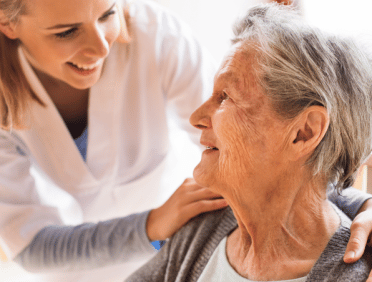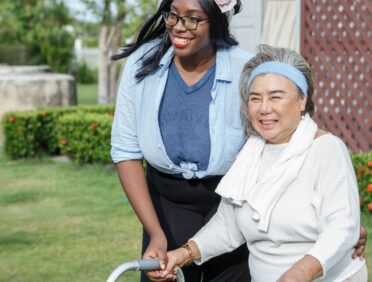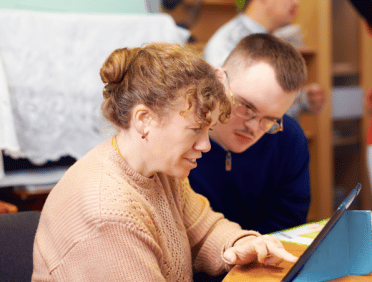Filter by
The protection of individuals, particularly those who are vulnerable due to age, disability, or circumstance, is a critical obligation for numerous professionals in the UK, regardless of sectors. The objective of this guide is to provide individuals and organisations with the necessary knowledge and practical measures to safeguard adults from exploitation, neglect, and abuse. Your role in safeguarding is critical, regardless of whether you are a healthcare professional, teacher, social worker, or community leader.
Understanding Adult Safeguarding
Adult safeguarding is the process of safeguarding vulnerable individuals from exploitation, neglect, and abuse. This encompasses people who are elderly, have physical or mental disabilities, or are unable to defend themselves as a result of specific circumstances, such as homelessness or addiction. There are numerous varieties of abuse, such as neglect, financial, emotional, sexual, or physical.
Key Principles of Safeguarding Adults
Promoting the autonomy, safety, and well-being of vulnerable individuals are the primary objectives of the Care Act 2014, which delineates the fundamental principles of safeguarding adults in the United Kingdom.
These principles encompass empowerment, which guarantees that individuals have the ability to influence decisions that affect them, and prevention, which emphasises proactive measures to prevent abuse before it occurs. In conjunction, these principles serve as the cornerstone of successful safeguarding initiatives.
Empowerment
Individuals should be motivated to make their own decisions and provided with the necessary information to do so. Safeguarding should advance autonomy, guaranteeing that individuals have the ability to manage their own affairs. Empowering an elderly individual to make their own care decisions, for instance, promotes a sense of dignity and independence.
Prevention
Safeguarding is contingent upon the implementation of proactive measures to avert damage. This may entail the development of policies that safeguard individuals prior to the occurrence of incidents, the training of staff, and the promotion of cognisance of the indicators of abuse. Preventative measures are indispensable in decreasing the probability of maltreatment occurring in the first place.
Proportionality
The response to safeguarding concerns should be proportional to the risk. Not all circumstances necessitate drastic measures; responses should be proportional to the severity of the threat or damage. This guarantees that intervention does not do more than is necessary to erode the adult’s independence or rights.
Protection
People who are incapable of safeguarding themselves from injury necessitate safeguarding interventions. Professionals are required to implement protective measures, including reporting concerns and collaborating with safeguarding teams, to safeguard those who are most vulnerable.
Partnership
Collaborative efforts between organisations, families, and communities are absolutely necessary now. Organisations such as the NHS, social services, and law enforcement must collaborate to guarantee the safety of individuals, which is a multi-agency process known as safeguarding.
Accountability
Transparency in how safeguarding procedures are carried out is an absolute necessity. Clear policies, training, and oversight are essential for organisations to guarantee that safeguarding measures are implemented and evaluated appropriately.
Types of abuse and neglect
The identification of safeguarding concerns requires a fundamental understanding of the many types of abuse. Therefore, it is crucial for people responsible for safeguarding to detect the indicators of abuse and take action to prevent harm to vulnerable adults. Each type of abuse can have a significant impact on the wellbeing of an adult who is vulnerable.
Physical abuse
Hitting, slapping, pushing, or misusing medication are all examples of this type of abusive behaviour. Despite the fact that it is frequently the most obvious kind of abuse, it can also be hidden in settings such as nursing homes or hospitals.
Emotional or psychological abuse
Threats, intimidation, isolation, and control are all examples of this term. Because of the persistent nature of the mistreatment, emotional abuse can have a significant influence on a person’s mental health and overall wellness.
Sexual abuse
The act of sexually assaulting another person without their consent, including but not limited to rape, indecent exposure, and sexual harassment. Because of the possibility that vulnerable persons will have difficulty disclosing sexual abuse due to feelings of shame or fear, it is essential for clinicians to be able to recognise the indicators.
Neglect
As a result of failing to provide appropriate care, the individual may suffer bodily or emotional injury. Many different environments, such as residential homes, hospitals, or even the individual’s own house, are all potential places where neglect can take place.
Financial or material abuse
This includes committing theft, fraud, or using coercion in order to steal the property or funds of an individual. The issue of financial exploitation is becoming increasingly prevalent, particularly among persons of retirement age, and it has the potential to have a disastrous impact on their capacity to live freely.
Discriminatory abuse
Being unfair to someone because of their colour, gender, handicap, or any other protected feature is a kind of discrimination. Abuse that is discriminatory can be overt, such as verbal harassment, or it can be more covert, such as restricting access to services or opportunities.
Organisational abuse
Care practices that are not up to par within an institution or care setting, such as insufficient staffing, neglect, or a rigid regime that does not take into account the requirements of the individual. This type of abuse can be systematic, and it is necessary for safeguarding teams to conduct in-depth investigations into the matter.
Self-neglect
When a person fails to take care of themselves, which ultimately leads to someone else being harmed. Whether it be due to physical or mental health difficulties, self-neglect frequently necessitates action in order to guarantee the individual’s safety.
How to Identify Signs of Abuse
Identifying the indicators of abuse is essential for the protection of vulnerable individuals. Physical signs may include unexplained injuries such as burns or bruising, while behavioural signs may include sudden mood changes, withdrawal, or fearfulness around specific individuals.
Neglect or financial abuse may be suggested by situational indicators, including inadequate living conditions, inadequate care, or the absence of personal items. Vulnerable individuals can be safeguarded from additional harm, and their safety and well-being can be promptly addressed by early identification of these indicators.
Physical signs
Burns, cuts, bruises, or other injuries that cannot be explained. A change in one’s physical appearance, such as a rapid loss of weight or a lack of proper cleanliness, can also be an indication of neglect.
Behavioural signs
A sudden shift in mood, depression, retreat from social activities, or fearfulness are all symptoms that may be present. People may exhibit symptoms of anxiety when they are in the presence of particular people or settings.
Financial signs
Unexpected withdrawals from accounts, the disappearance of valuables, or alterations in one’s financial routines are considered suspicious. Exploitation of a person’s financial situation can sometimes go unchecked, particularly in situations when the adult is dependent on other people to manage their cash.
Situational signs
Poor living conditions, which may include a lack of appropriate food or heating, as well as environments that are not sanitary. These situations may be indicative of neglect, particularly in situations when the adult is dependent on carers or services for their well-being.
Responding to safeguarding concerns
When safeguarding concerns arise, it is imperative to act promptly and appropriately. Initially, consider the individual’s concerns seriously and listen attentively, ensuring that they feel heard and supported. Document any pertinent information accurately in accordance with your organisation’s safeguarding protocols. Report the issue.
Collaborating with other organisations, such as those that provide social services or law enforcement, might be required in order to provide a comprehensive response. Respecting the individual’s wishes and rights is also crucial, unless they are incapable of making decisions. In such cases, the safety and well-being of the individual should be the primary concern.
Listen and believe
If someone comes forward to report abuse, you should take them seriously. It is of the utmost importance to arrange a setting that is secure and encouraging for the individual to communicate.
Report your concerns
The safeguarding policy of an organisation is something that professionals are required to adhere to. This policy often requires professionals to report concerns to a safeguarding lead or directly to adult safeguarding teams.
Document everything
The maintenance of accurate records is absolutely necessary for the protection of cases. Document any occurrences, disclosures, or concerns in great detail, making sure that the facts are reported in a way that is both clear and precise.
Multi-agency collaboration
On rare occasions, a single agency is responsible for safeguarding. The adult will be protected by a coordinated response that is ensured by working with social services, healthcare providers, law enforcement, and any other necessary agencies.
Respect the individual’s wishes
Adults have the freedom to make their own decisions, even if they decide not to defend themselves against the abuse that they have experienced. In situations when an adult does not possess the mental capacity to make decisions, however, safeguarding teams may be required to intervene in the best interests of the adult.
Prevention and Safeguarding Policies
On the same level of importance as responding to abuse is the prevention of abuse. In order to protect vulnerable adults, organisations need to develop stringent safeguarding policies and make certain that their employees have enough training to identify and address concerns.
Training
Regular training in safeguarding measures for all staff members helps to improve awareness and ensures that professionals are able to recognise concerns and respond to them in a timely and efficient manner. The many forms of abuse, the warning indicators to look out for, and the report-making procedure must be included in this training.
Clear reporting structures
Each and every organisation must have a transparent and well-communicated process for reporting issues about the protection of individuals. Consequently, this guarantees that professionals are aware of their responsibilities and are able to take action without hesitation whenever concerns occur.
Community Engagement
The promotion of community awareness of safeguarding issues can contribute to the establishment of a culture of vigilance, in which individuals such as neighbours, acquaintances, and family members are vigilant for potential indications of abuse or neglect.
Creating Safe Environments
Whether in care homes, schools, hospitals, or community settings, it is essential to establish secure environments by implementing effective personnel practices, conducting regular inspections, and practicing open communication. The prevention of abuse is contingent upon the availability of support services and the recognition of the voices of vulnerable individuals.
Legal responsibilities and resources
The protection of vulnerable individuals is a significant responsibility of professionals and organisations in the United Kingdom, as determined by law. The Mental Capacity Act 2005, the Care Act 2014, and the Human Rights Act 1998 establish the legal framework for safeguarding. Local Safeguarding Adults Boards (SABs) are accountable for the coordination of multi-agency responses and the enforcement of safeguarding policies.
Guidance from the NSPCC, Barnardo’s, and government agencies such as the Care Quality Commission (CQC) are among the numerous resources available to assist professionals with safeguarding needs. These organisations provide training, support, and advice on the most effective methods for protecting vulnerable adults.
Frequently Asked Questions (FAQs)
The practice of safeguarding adults involves the protection of an individual’s right to live in a secure environment, free from abuse and neglect. The reason for its importance is that vulnerable individuals may not always be able to safeguard themselves from harm, whether as a result of mental or physical impairments. Safeguarding is a legal requirement in the United Kingdom to guarantee the protection of individuals who are at risk.
Safeguarding adults entails the prevention of abuse and neglect, the resolution of incidents when they occur, and the empowerment of adults to make their own decisions. This guarantees that vulnerable individuals are provided with care and protection while simultaneously preserving their autonomy and dignity.
This is subject to UK legislation, which includes the Care Act 2014, which defines the responsibilities of local authorities, healthcare professionals, and other agencies in order to effectively protect individuals.
The significance of safeguarding is its capacity to prevent injury to individuals who may be unable to defend themselves due to disabilities, mental health issues, age, or other factors. Ensuring the protection of these individuals’ rights is crucial for their well-being and the ability to live independently and with dignity.
The protection of adults helps to create a safe environment for everyone, including the community and those who provide care for the elderly.
Under UK law, an adult at risk, or vulnerable adult, is an individual who is 18 years of age or older and may require care and support as a result of physical or mental health issues, disabilities, age, or other factors. These individuals may be vulnerable to abuse or neglect due to their inability to safeguard themselves from harm or exploitation.
Under the Care Act 2014, an adult is classified as vulnerable if they are unable to secure themselves due to their care and support needs, are at risk of abuse or neglect, or have care and support needs. Included in this category are individuals with cognitive disabilities, dementia, mental health issues, and physical or mental disabilities, as well as the elderly.
Note that vulnerability can fluctuate over time, and circumstances may shift as a result of illness or crisis.
The term “vulnerable adult” also extends to individuals who may be experiencing transient vulnerabilities, such as those who are recovering from surgery or coping with a sudden bereavement. The safeguarding procedure must be tailored to the specific circumstances of each individual and must acknowledge their unique needs.
The objective of safeguarding vulnerable adults is to provide these individuals with the necessary support systems to prevent damage while also empowering them. Agencies and professionals are responsible for evaluating and addressing the care requirements of these individuals, collaborating to ensure their safety.
Safeguarding vulnerable individuals in the United Kingdom encompasses a variety of forms of abuse, each of which has the potential to negatively impact their well-being. Abuse can manifest in various forms, including physical, emotional, sexual, financial, or neglectful. In order to guarantee the safety and protection of the adult at risk, each form of abuse needs a customised response.
Physical abuse is the act of causing physical damage to an individual, such as hitting, slapping, or the misuse of medication. Emotional abuse encompasses behaviours that diminish an individual’s self-esteem or mental health, such as verbal harassment, intimidation, or threats.
Financial abuse is the illicit or improper use of an individual’s money or property, while sexual abuse is any non-consensual sexual activity or contact. Neglect is an additional significant issue, as it pertains to the neglect of fundamental requirements, including sustenance, shelter, and medical care.
Domestic violence, discriminatory abuse (which targets individuals based on race, gender, disability, etc.), and organisational abuse (which occurs when the routines and practices within a care setting are inadequate and result in neglect or poor treatment) are other forms of abuse that fall under safeguarding.
Modern slavery, which encompasses forced labour and human trafficking, is also acknowledged as a form of maltreatment under safeguarding legislation.
According to UK law, including the Care Act 2014, a multi-agency approach is required to identify and respond to all forms of abuse, thereby guaranteeing the protection and support of vulnerable adults.
Ensuring the safety of vulnerable individuals necessitates the identification of indicators of neglect or abuse. These indicators may differ depending on the type of abuse, but they may encompass physical injuries, behavioural modifications, withdrawal, dread, and unexplained financial circumstances. Individuals may be safeguarded from additional injury by promptly recognising these indicators.
Bruises, burns, fractures, or other injuries that are unexplained or appear to be inconsistent with an individual’s explanation are physical signs of abuse. Symptoms of emotional or psychological abuse may include abrupt withdrawal from social interactions, depression, or increased anxiety. These behaviours may indicate emotional abuse, such as the avoidance of eye contact, dread, or unusual submissiveness.
Financial abuse may manifest as sudden changes in financial decisions, missing possessions, or unexplained bank withdrawals. Neglect may be apparent when an individual’s fundamental requirements are not being satisfied, including inadequate hygiene, malnutrition, untreated medical conditions, or hazardous living conditions.
Physical indicators, such as discolouration in sensitive areas, may be present in cases of sexual abuse; however, emotional symptoms, such as anxiety or distress, are frequently more indicative.
Remember that not all indications of maltreatment are immediately apparent. Identifying when an individual may be at risk can be facilitated by open communication and meticulous observation. Should you have any suspicions of abuse, it is of the utmost importance to take prompt action in order to safeguard the vulnerable individual.
Safeguarding adults is a shared responsibility among a variety of organisations and individuals in the United Kingdom. Local authorities, healthcare providers, social care services, the police, and other agencies that collaborate with vulnerable individuals comprise this category. The ultimate goal is to ensure that the welfare and well-being of individuals who are at risk is properly addressed.
The Care Act 2014 mandates that local authorities act as the lead for adult safeguarding initiatives. They are accountable for the coordination of investigations, the implementation of safeguarding plans, and the provision of appropriate support and protection to adults who are at risk.
Concerns must be identified and reported to the appropriate authorities, and a collaborative effort must be made to mitigate any potential safety hazards. Health and social care professionals are essential in this process.
Criminal activities, including physical assault, financial fraud, or domestic violence, necessitate the involvement of the police. Assisting in the protection of victims and the accountability of perpetrators, they collaborate with other organisations. Regulatory obligations necessitate that care providers, such as hospitals and residential homes, adhere to safeguarding protocols and report any concerns.
Safeguarding is ultimately the responsibility of all individuals. When encountering a vulnerable adult, it is crucial to remain vigilant and disclose any concerns to guarantee that they receive the requisite support and protection.
If you have reason to believe that an adult is being neglected or exploited, it is imperative that you act immediately. The safety and well-being of the vulnerable adult should be your primary concern. Despite the fact that the precise steps may differ depending on the circumstances, safeguarding protocols in the United Kingdom offer direct guidance for addressing such concerns.
One of the initial steps is to guarantee the immediate protection of the adult who is at risk. Should they be in immediate peril or require urgent medical attention, contact emergency services at 999 without delay.
Avoiding direct confrontation with the alleged abuser is crucial, as this could potentially escalate the situation and expose the vulnerable adult to additional danger. On the contrary, prioritise the provision of a secure environment and the provision of assistance to the individual.
Now that their immediate safety has been ensured, it is of the utmost importance to document any concerns that you may have, including the circumstances, the observations that you made, and any concerns that you may have indications of neglect or abuse.
In the event that you are employed in a regulated environment, such as healthcare or social care, follow the internal safeguarding procedures of your organisation and notify your safeguarding director or manager of the incident.
The adult safeguarding team of the local authority can be contacted directly if you are a member of the public or do not have access to formal procedures.
Acting on your concerns could make a significant difference in protecting a vulnerable adult from further harm, so it is essential to report your suspicions without hesitation.
Reporting a safeguarding concern for an adult in the United Kingdom is an essential measure in safeguarding individuals from neglect or abuse. The primary agencies responsible for managing safeguarding concerns are local authorities. However, certain organisations, such as the police and health services, may also be involved, contingent upon the nature of the abuse.
Your local authority’s adult safeguarding team should be contacted to disclose a safeguarding concern. Their contact information is typically accessible on the website of the appropriate local council. There are numerous councils that offer dedicated phone lines or online forms for the purpose of reporting concerns.
As much detail as feasible should be included in the report, including the name of the adult at risk, the nature of your concerns, and any evidence or observations you have. Emergency services should be contacted at 999 if the adult is in imminent danger.
Professionals employed in regulated sectors, including healthcare, social care, and education, are required to adhere to their organisation’s safeguarding policies and communicate any concerns through the appropriate internal channels. Even so, they may still be required to submit a formal referral to the local authority if the issue is of a severe or urgent nature.
If you are hesitant to disclose your identity, you may submit an anonymous report; however, it is generally recommended that you provide your contact information to facilitate the investigation. After reporting, the safeguarding team will evaluate the information and take the necessary steps to protect and investigate the individual.
Following the reporting of a safeguarding concern, the local authority is accountable for conducting an investigation and implementing measures to safeguard the vulnerable adult. The process typically entails the evaluation of the risk, the investigation of the allegations, and the coordination of an appropriate response. The adult’s safety and well-being are always the primary concern.
The initial risk assessment is the initial action that the local authority takes upon receiving a report. This will ascertain the urgency of the situation and whether immediate action is necessary to safeguard the individual. The local authority may arrange emergency services, temporary accommodation, or medical assistance if urgent intervention is required. Concurrently, they will collect additional information from the individual who submitted the report and potentially other pertinent parties.
Following the initial assessment, the local authority’s adult safeguarding team will conduct a comprehensive safeguarding inquiry. Depending on the nature of the issue, this inquiry may have the involvement of multiple agencies, such as the police, healthcare providers, and social services.
The vulnerable adult’s wishes and perspectives are essential to the decision-making process during the investigation. In order to safeguard them from additional injury, we will implement safeguarding measures and potentially create a safeguarding plan.
After the inquiry is concluded, the results are evaluated and suggestions are issued to guarantee the adult’s ongoing safety. The situation will be monitored by the local authority in order to ensure that the preventative measures are effective in meeting their intended purpose.
If an offence has been committed, legal action may be taken against the perpetrator in certain instances.
The Care Act 2014 is a critical piece of legislation in the United Kingdom that defines the duties of local authorities with respect to the care and support of adults, particularly those who are at risk of neglect or abuse.
Specifically, it establishes guidelines for the prevention of abuse incidents and the response to those that have already occurred, as well as the legal framework for the protection of adults.
Local authorities must implement a proactive safeguarding strategy in accordance with the Care Act 2014. This involves identifying vulnerable adults, intervening when necessary, and collaborating with other agencies to ensure their safety.
The act establishes a legal obligation for local authorities to investigate concerns and provide appropriate support to individuals in need of care, thereby incorporating safeguarding as a statutory duty.
“Making Safeguarding Personal” is one of the Care Act’s fundamental principles, which underscores the importance of involving the adult at risk in the decision-making process regarding their own care and protection. The act promotes a person-centred approach that assures the individual’s dignity and respect throughout the safeguarding procedure, prioritising their wishes and rights.
The Care Act mandates that local authorities establish Safeguarding Adults Boards (SABs) to supervise safeguarding policies and practices. The responsibility of these committees is to ensure the effectiveness of safeguarding strategies and to coordinate multi-agency efforts to protect adults.
The Care Act 2014 instituted a statutory body known as the Safeguarding Adults Board (SAB). Its primary objective is to supervise and coordinate local safeguarding initiatives in order to safeguard adults who are at risk of neglect or abuse. SABs are essential in ensuring that agencies collaborate effectively to protect vulnerable individuals in their region.
SABs are primarily responsible for the development and implementation of safeguarding policies and strategies, the promotion of awareness of safeguarding issues, and the monitoring of the efficacy of local safeguarding services. Key stakeholders, including local authorities, NHS organisations, and the police, are mandated to be included in SABs.
A collaborative effort is being made by these partners in order to ensure that the safeguarding arrangements are robust and that professionals from a variety of fields are well coordinated.
SABs are also accountable for conducting safeguarding adult reviews (SARs) in instances where an adult has perished or experienced severe harm as a result of neglect or abuse. The purpose of these evaluations is to prevent the recurrence of similar incidents, identify areas for improvement, and learn from such cases.
The findings and recommendations from these evaluations are subsequently shared with the appropriate organisations by SABs.
Ultimately, the function of a SAB is to guarantee the protection of vulnerable adults in the local community from damage and to hold agencies accountable for their safeguarding responsibilities. The board’s efforts contribute to the establishment of secure environments for adults at risk and the ongoing enhancement of safeguarding practices.
The “Making Safeguarding Personal” (MSP) approach underscores the significance of integrating the adult at risk into their own safeguarding decisions. The objective is to transition safeguarding from a process-driven approach to a person-centred approach that prioritises the individual’s preferences, requirements, and desired outcomes.
This method is founded on the principles of autonomy and empowerment.
The MSP approach guarantees that safeguarding interventions are customised to the unique circumstances of the individual and that the adult has a voice in the process of being protected. This necessitates collaboration with the adult to ascertain their objectives, risk factors, and potential sources of assistance. The focus is on the individual’s quality of life benefits rather than merely adhering to procedural steps.
Professionals must engage the adult in meaningful conversations to ensure that their wishes are considered and that they are listened to in order for MSP to function effectively. This could entail offering advocacy services to assist the adult in expressing their opinions.
Professionals are encouraged to pursue solutions that are guided by the adult’s perspective while maintaining their obligation to safeguard them from harmful situations. MSP has been widely acknowledged as a positive development in the direction of more effective and compassionate safeguarding practices.
According to the Care Act 2014 and professional regulatory guidelines, healthcare professionals in the United Kingdom are subject to specific legal obligations with respect to the protection of adults. If they have concerns about the safety or welfare of an adult at risk, they are obligated to take action and adhere to safeguarding protocols in order to report and address these incidents.
Healthcare professionals have a responsibility to detect and respond to indicators of neglect or abuse. Professional bodies, including the General Medical Council (GMC) and the Nursing and Midwifery Council (NMC), underscore this obligation by mandating that their members prioritise patient safety.
Healthcare professionals are required to be vigilant for indicators of abuse, including physical, emotional, and financial abuse, and to take the necessary measures to safeguard the individuals.
Healthcare professionals must adhere to established procedures for information sharing when necessary and collaborate with local authorities and other agencies to protect investigations under the Care Act. They are also required to take part in safeguarding training in order to ensure that they are able to identify concerns and respond to them in an appropriate manner.
This is a mandatory requirement. Disciplinary action by regulatory bodies or legal repercussions if negligence leads to damage may result from neglecting these obligations.
Specific safeguarding training is mandatory for professionals who work with vulnerable individuals in order to provide them with the necessary skills and knowledge to identify and address situations of abuse or neglect. This training is indispensable for guaranteeing that safeguarding procedures are consistent, efficient, and in accordance with the legal and regulatory framework of the United Kingdom.
The most common components of safeguarding training are an overview of the Care Act 2014 and other pertinent legislation, the identification of indicators of abuse or neglect, the types of abuse, and the comprehension of safeguarding procedures. It also addresses the principles of “making safeguarding personal,” which underscores the significance of a person-centred approach to safeguarding.
Training may differ based on the professional’s position, with more comprehensive courses for those in senior positions or those directly responsible for safeguarding decisions.
It is mandatory for healthcare workers, social workers, care staff, and other professionals in comparable positions to attend routine refresher training in order to remain informed about legislative updates and industry standards. Specific safeguarding training levels are also required by local authorities and professional organisations.
Level 1 training may be adequate for administrative personnel, whereas Level 3 or higher is required for those who are directly responsible for administering safeguarding cases.
Professionals are more capable of identifying concerns early, comprehending their responsibilities, and taking the necessary measures to safeguard vulnerable adults by completing safeguarding training.
Care workers in residential homes are legally and morally obligated to take action immediately if they observe signs of maltreatment. Their primary objective should be to guarantee the safety and welfare of the individual in question. Effectively addressing the abuse and safeguarding the resident from further damage necessitates adhering to explicit safeguarding protocols.
The first step is to notify the manager or safeguarding lead of the residential home of the abuse. Care workers are required to meticulously record their observations, which should include the specifics of the event, the location and time, and the individuals involved. This documentation may be essential for subsequent investigations.
Care workers should refrain from conducting their own investigations, as this could potentially disrupt formal safeguarding protocols.
If the care worker believes that their concerns are not being addressed or that the management is not taking the necessary steps, they have the right to escalate the issue to external agencies, such as the Care Quality Commission (CQC) or the safeguarding team of the local authority. While the concern is being addressed, it is also crucial to guarantee the resident’s safety.
The individual may be relocated to a secure environment, or medical attention may be sought if necessary through immediate measures.
Under UK law, whistleblower protections guarantee that care workers who report concerns in good faith are not subject to penalties for raising safeguarding issues. This legal protection motivates care workers to act with assurance when they suspect maltreatment.
Even if an adult declines assistance, safeguarding measures can be implemented; however, this must be done with meticulous attention to the individual’s autonomy and rights. The fundamental tenet of safeguarding is to enable adults to make their own decisions whenever feasible while simultaneously guaranteeing their protection.
Nevertheless, safeguarding professionals must strike a balance between their obligation to protect and the wishes of an adult who is at substantial risk.
An adult who possesses the mental capacity to make that decision is entitled to decline safeguarding interventions under the Care Act 2014. Professionals are required to accept the adult’s decision in these circumstances, unless there is a threat to others or a crime has been committed.
Nevertheless, professionals should persist in providing assistance, monitoring the situation, and attempting to engage the individual in dialogue to identify solutions to their concerns, even if the adult rejects assistance.
Professionals may act in the best interests of an adult if there is evidence that the adult lacks mental capacity to make decisions about their safety (Mental Capacity Act 2005). This may involve the implementation of protective measures, such as the intervention of other agencies, the provision of medical care, or the removal of the adult from a hazardous situation.
In the event that capacity is in question, assessments should be conducted by trained professionals, and any actions taken must be the least restrictive necessary to safeguard the individual.
Professionals may be required to implement immediate protective measures in situations where an adult is at imminent risk of injury, regardless of the individual’s preferences. Local authorities, healthcare providers, and law enforcement collaborate to minimise injury while simultaneously upholding the rights of the individual.
A safeguarding plan is a structured approach that is intended to safeguard a vulnerable adult from further neglect or abuse. After an investigation of a safeguarding concern, it is developed and customised to the unique requirements and circumstances of the individual. The objective is to guarantee the individual’s autonomy and rights are upheld while simultaneously reducing risks, improving their safety, and promoting their well-being.
The execution of a safeguarding plan necessitates the interoperation of numerous agencies, including healthcare providers, local authorities, and social services. The plan will specify the specific measures necessary to safeguard the individual, such as the allocation of supplementary support services, the modification of care arrangements, or the withdrawal of the individual from a hazardous environment.
Not only does it outline the individuals who are responsible for each action, but it also specifies the timelines for review and surveillance.
The safeguarding plan process is integral to the adult at risk, and their preferences are considered when feasible in the decision-making process. Decisions are made in the best interests of the adult in situations where they lack capacity, in accordance with the Mental Capacity Act 2005.
The plan is a living document that undergoes regular evaluation to guarantee that it remains relevant and efficient in the face of evolving circumstances. The emphasis is on the individual’s capacity to live as independently as feasible while also ensuring their long-term safety and well-being.
Legal protections are in place to ensure that whistleblowers who disclose adult safeguarding concerns in the United Kingdom can raise concerns about abuse or neglect without fear of retribution. These legal safeguards are provided by the Public Interest Disclosure Act 1998 (PIDA), which guarantees that employees who disclose misconduct are protected from victimisation, dismissal, or unjust treatment.
PIDA provides legal protection to whistleblowers who report a safeguarding concern that fulfils the criteria of a “protected disclosure.” This typically entails the reporting of information regarding criminal activity, gross misconduct that places vulnerable individuals at risk, or endangerment to health and safety. Disclosed to an appropriate authority, such as a regulatory body or safeguarding director within an organisation.
A whistleblower who adheres to the appropriate procedures is entitled to protection from dismissal and detriment in their employment. If an employee is subjected to adverse consequences as a consequence of whistleblowing, they are entitled to file a complaint with an employment tribunal against their employer.
Whistleblowers are motivated to disclose concerns in good faith in regulated sectors such as healthcare and social care, as they are aware that legal safeguards are in place to facilitate their actions.
These safeguards are essential for fostering the confidence of individuals to report safeguarding concerns, thereby preventing additional injury to vulnerable adults.
There is a delicate equilibrium to be struck in safeguarding investigations between the necessity of ensuring the safety of an individual and the preservation of their autonomy, dignity, and rights. This includes compliance with legal principles, including the Mental Capacity Act 2005, which guarantees that individuals are permitted to make their own decisions whenever feasible, and the Care Act 2014, which establishes the framework for safeguarding practices.
The principle of “making safeguarding personal” is essential in achieving this equilibrium. Involving the adult at risk in decisions regarding their care and protection, this person-centred approach prioritises their preferences whenever feasible. If the individual has the capacity to make decisions, their opinions are considered, regardless of whether they opt not to accept assistance.
Professionals are required to furnish the individual with comprehensive information regarding the hazards and available support options, thereby enabling them to make well-informed decisions.
When an adult lacks capacity, professionals must act in their best interests while seeking the least restrictive interventions possible to safeguard them. A critical function of risk assessments is to assess the severity of the damage and establish the appropriate level of intervention. Multidisciplinary teams collaborate to conduct a comprehensive evaluation of the situation, guaranteeing the individual’s safety while honouring their rights to independence, privacy, and self-determination.
Safeguarding plans and ongoing evaluations are implemented to guarantee that these rights are consistently enforced.
The Care Act 2014 delineates the critical function of local authorities in the UK in the protection of adults. They are the primary agencies responsible for the coordination of safeguarding efforts, the investigation of concerns, and the protection of vulnerable individuals from neglect and abuse. Their responsibilities include proactive prevention and responsive intervention.
Local authorities are accountable for conducting safeguarding enquiries when safeguarding concerns are identified. This includes the collection of information, the evaluation of the adult’s risk, and the coordination with other authorities, including the police, the NHS, and social services. The implementation and evaluation of a safeguarding plan are overseen by the local authority, if necessary.
Local authorities are also responsible for fostering adult safeguarding within the community. Through the provision of training and support to professionals, as well as the raising of awareness regarding safeguarding issues, it is their responsibility to ensure that safeguarding policies and procedures are implemented across all services.
The Safeguarding Adults Boards (SABs) are chaired by local authorities, who convene diverse agencies to establish accountability across sectors and collaborate on safeguarding strategies.
Ultimately, local authorities act as the central hub for adult safeguarding efforts, ensuring that vulnerable adults receive the protection and care they need while promoting best practices within the community.
Financial abuse and exploitation of vulnerable individuals are the subject of safeguarding measures in the United Kingdom. Under the Care Act 2014, financial abuse is a recognised form of abuse, and safeguarding mechanisms are in place to protect adults at risk from exploitation, fraud, or financial manipulation. This form of maltreatment can be particularly detrimental, resulting in the loss of financial independence and overall well-being.
Actions such as theft, fraud, coercion, or manipulation may be employed to obtain control over the finances of a vulnerable individual who is experiencing financial abuse. Misuse of benefits, imposition of modifications to wills, unauthorised withdrawals from bank accounts, or seizure of property are all potential components. Adults who are isolated from support networks, have cognitive impairments, or have physical disabilities are frequently the victims of financial exploitation.
The local authority will conduct an investigation when a safeguarding concern involving financial exploitation is reported. It may be necessary to work together with financial institutions, legal services, and other organisations in order to protect the individual’s assets and stop any further sexual exploitation from occurring.
In the event that the adult lacks mental capacity, safeguarding measures may involve the appointment of a trusted individual to oversee the adult’s finances, the pursuit of legal remedies, such as closing accounts, or the application for a Court of Protection order.
In financial abuse cases, the objective of safeguarding is to prevent future damage and restore the adult’s financial stability, in addition to halting the exploitation. Support services and education may also be offered to assist the individual in establishing a more secure financial management system in the future.















